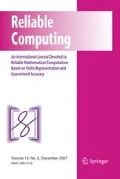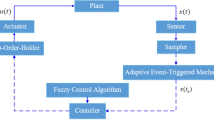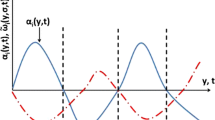Abstract
Functional input uncertainty is investigated for linear time-invariant (LTI) systems. This kind of uncertainty arises, for instance, when actuator's reliability is taken into account. In this case, the system input u(t) can be considered as a fuzzy function, ũ(t), with α-cut interpreted as the set of functions between the given bounds. Based on the use of functional intervals and Aumann's integral from set-valued analysis, a method is presented to obtain an approximation of arbitrary precision of the output envelopes. Given a precision, an approximation with this exactly precision can be obtained. With this method, wrapping effect is avoided.
Similar content being viewed by others
References
Ackermann, J.: Robust Control. Systems with Uncertain Physical Parameters, Springer-Verlag, 1993.
Aubin, J. P. and Cellina, A.: Differential Inclusions, Springer Verlag, 1984.
Aubin, J. P. and Frankowska, H.: Set-Valued Analysis, Birkhauser, 1990.
Barber, C., Dobkin, D., and Huhdanpaa, H.: The Quickhull Algorithm for Convex Hulls, Mathematical Software 22 (1997), pp. 469–483.
Barmish, B. R.: New Tools for Robustness of Linear Systems, Macmillan Publishing Company, 1994.
Bauch, H. and Kimmel, W.: Solving Ordinary Initial Value Problems with Guaranteed Bounds, Z. angew. Math. Mec. 69 (1989).
Bhattacharyya, S. P., Chapellat, H., and Keel, L. H.: Robust Control. The Parametric Approach, Prentice Hall, 1995.
Bochev, P. and Markov, S.: A Self-Validating Numerical Method for the Matrix Exponential, Computing 43(1) (1989), pp. 59–72.
Bonarini, A. and Bontempi, G.: A Qualitative Simulation Approach for Fuzzy Dynamical Models, Modeling and Computer Simulation 4(4) (1994), pp. 285–313.
Bondia, J.: Sistemas con incertidumbre paramétrica borrosa: análisis y diseño de controladores, Dept. of Systems Engineering and Control, Valencia Technical University, 2002.
Bondia, J. and Picó, J.: A Geometric Approach to Robust Performance of Parametric Uncertain Systems, International Journal of Robust and Nonlinear Control 13(14) (2003), pp. 1271–1283.
Bondia, J. and Picó, J.: Analysis of Linear Systems with Fuzzy Parametric Uncertainty, Fuzzy Sets and Systems 135 (2003), pp. 81–121.
Bondia, J. and Picó, J.: On the Robust Performance of Fuzzy Linear Systems: in: Proceedings of the IFAC Workshop on Advanced Fuzzy-Neural Control, Valencia, Spain, 2001.
Buckley, J. J. and Feuring, T.: Fuzzy Differential Equations, Fuzzy Sets and Systems 110 (2000), pp. 43–54.
Cooper, G. F.: Probabilistic Inference Using Belief Networks Is NP-Hard, KSL-87-27, Medical Computer Science Group, Stanford University, 1987.
Corliss, G. F.: Survey of Interval Algorithms for Ordinary Differential Equations, Appl. Math. Comput. 31 (1989).
Diamond, P.: Time-Dependent Differential Inclusions, Cocycle Attractors and Fuzzy Differential Equations, IEEE Transactions on Fuzzy Systems 7(6) (1999), pp. 734–740.
Dobner, H.-J.: Verified Solutions of Integral Equations with Applications, in: Adams, E. and Kulisch, U. (eds), Scientific Computing with Automatic Result Verification, Academic Press, San Diego, 1993, pp. 225–253.
Drakopoulos, J.: Probabilities, Possibilities, and Fuzzy Sets, KSL-94-40, Knowledge Systems Laboratory, Department of Computer Science, Stanford University, 1994.
Dubois, D. and Prade, H.: Possibility Theory: An Approach to Computerized Processing of Uncertainty, Plenum Press, 1988.
Eijgenraam, P.: The Solution of Initial Value Problems Using Interval Arithmetic, Mathematical Centre Tracts 144, Stichting Mathematisch Centrum, Amsterdam, 1981.
Fisher, H.: Acceptable Solutions of Linear Integral Equations, in: Nickel, K. (ed.), Interval Mathematics 1985: Proc. of the International Symposium, Freiburg, Springer-Verlag, Vienna, 1985, pp. 11–16.
Hüllermeier, E.: A Fuzzy Simulation Method, http://citeseer.nj.nec.com/64062.html.
Hüllermeier, E.: An Approach to Modelling and Simulation of Uncertain Dynamical Systems, International Journal of Uncertainty, Fuzziness and Knowledge-Based Systems 5(2) (1997), pp. 117–137.
Janssen, M., Van Hentenryck, P., and Deville, Y.: A Constraint Satisfaction Approach to Parametric Differential Equations, in: Proc. of Joint International Conference on Artificial Intelligence (IJCAI-2001), Seattle, WA, 2001.
Kaleva, O.: Fuzzy Differential Equations, Fuzzy Sets and Systems 24 (1987), pp. 301–317.
Keller, U.: Qualitative Model Reference Adaptive Control, Heriot-Watt University, Dept. of Computing & Electrical Engineering, 1999.
Klir, G. J. and Wierman, M. J.: Uncertainty-Based Information, Physica Verlag, 1998.
Kühn, W.: Rigorously Computed Orbits of Dynamical Systems without the Wrapping Effect, Computing 61(1) (1998), pp. 47–67.
Lohner, R. J.: Einschlieβung der Lösung gewöhnlicher Anfangs-und Randwertaufgaben und Anwendungen, Universität Karlsruhe, 1988.
Lohner, R. J.: Enclosing the Solutions of Ordinary Initial and Boundary Value Problems, in: Kaucher, E.W., Kulisch, U.W., and Ullrich, C. (eds), Computer Arithmetic: Scientific Computation and Programming, Wiley-Tubner Series in Computer Science, Stuttgart, 1987, pp. 255–286.
Moore, R. E.: Interval Analysis, Prentice Hall, Englewood Cliffs, 1966.
Nedialkov, N. S. and Jackson, K. R.: A New Perspective on the Wrapping Effect in Interval Methods for Initial Value Problems for Ordinary Differential Equations, in: Kulisch, U., Lohner, R., and Facius, A. (eds), Perspectives on Enclosure Methods, Springer-Verlag, 2001, pp. 219–264.
Nedialkov, N. S., Jackson, K. R., and Corliss, G. F.: Validated Solutions of Initial Value Problems for Ordinary Differential Equations, Applied Mathematics and Computation 105(1) (1999), pp. 21–68.
Neumaier, A.: Global, Rigorous and Realistic Bounds for the Solution of Dissipative Differential Equations. Part I: Theory, Computing 52(4) (1994), pp. 315–336.
Neumaier, A.: The Wrapping Effect, Ellipsoid Arithmetic, Stability and Confidence Regions, Computing Supplementum 9 (1993), pp. 175–190.
Nickel, K.: Using Interval Methods for the Numerical Solution of ODE's, Z. angew. Math. Mec. 66 (1986).
Oppenheimer, E. P. and Michel, A. N.: Application of Interval Analysis Techniques to Linear Systems (II). The Interval Matrix Exponential Function, IEEE Transactions on Circuits and Systems 35(10) (1988), pp. 1230–1242.
Pedrycz, W.: Fuzzy Control and Fuzzy Systems, Research Studies Press, 1993.
Puri, M. L. and Ralescu, D. A.: Differential of Fuzzy Functions, Journal of Mathematical Analysis and Applications 91 (1983), pp. 552–558.
Rihm, R.: Interval Methods for Initial Value Problems in ODEs, in: Herzberger, J. (ed.), Topics in Validated Computations: Proceedings of the IMACS-GAMM International Workshop on Validated Computations, University of Oldenburg, Elsevier Studies in Computational Mathematics, Elsevier.
Rihm, R.: On a Class of Enclosure Methods for Initial Value Problems, Computing 53 (1994), pp. 369–377.
Stauning, O.: Solving Integral Equations Using Interval Analysis, Department of Mathematical Modelling, Technical University of Denmark, 1995.
Stetter, H. J.: Validated Solution of Initial Value Problems for ODEs, in: Ullrich, C. (ed.), Computer Arithmetic and Self-Validating Numerical Methods, Academic Press, New York, 1990, pp. 171–187.
Stewart, N.: A Heuristic to Reduce the Wrapping Effect in the Numerical Solution of x′ = f(t,x), BIT 11 (1971), pp. 328–337.
Terano, T., Asai, K., and Sugeno, M.: Fuzzy Systems Theory and Its Applications, Academic Press, 1992.
Yao, A. C.-C.: A Lower Bound to Finding Convex Hulls, J. ACM 28 (1981), pp. 780–787.
Zadeh, L. A.: Fuzzy Sets, Inf. Control 8 (1965), pp. 338–353.
Author information
Authors and Affiliations
Rights and permissions
About this article
Cite this article
Bondia, J., Picó, J. Application of Functional Intervals to the Response Evaluation of Linear Time-Invariant Systems with Fuzzy Input. Reliable Computing 10, 369–387 (2004). https://doi.org/10.1023/B:REOM.0000032119.66122.e5
Issue Date:
DOI: https://doi.org/10.1023/B:REOM.0000032119.66122.e5




